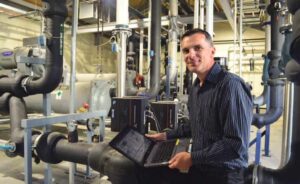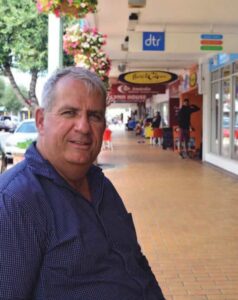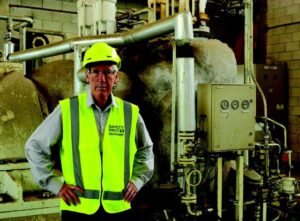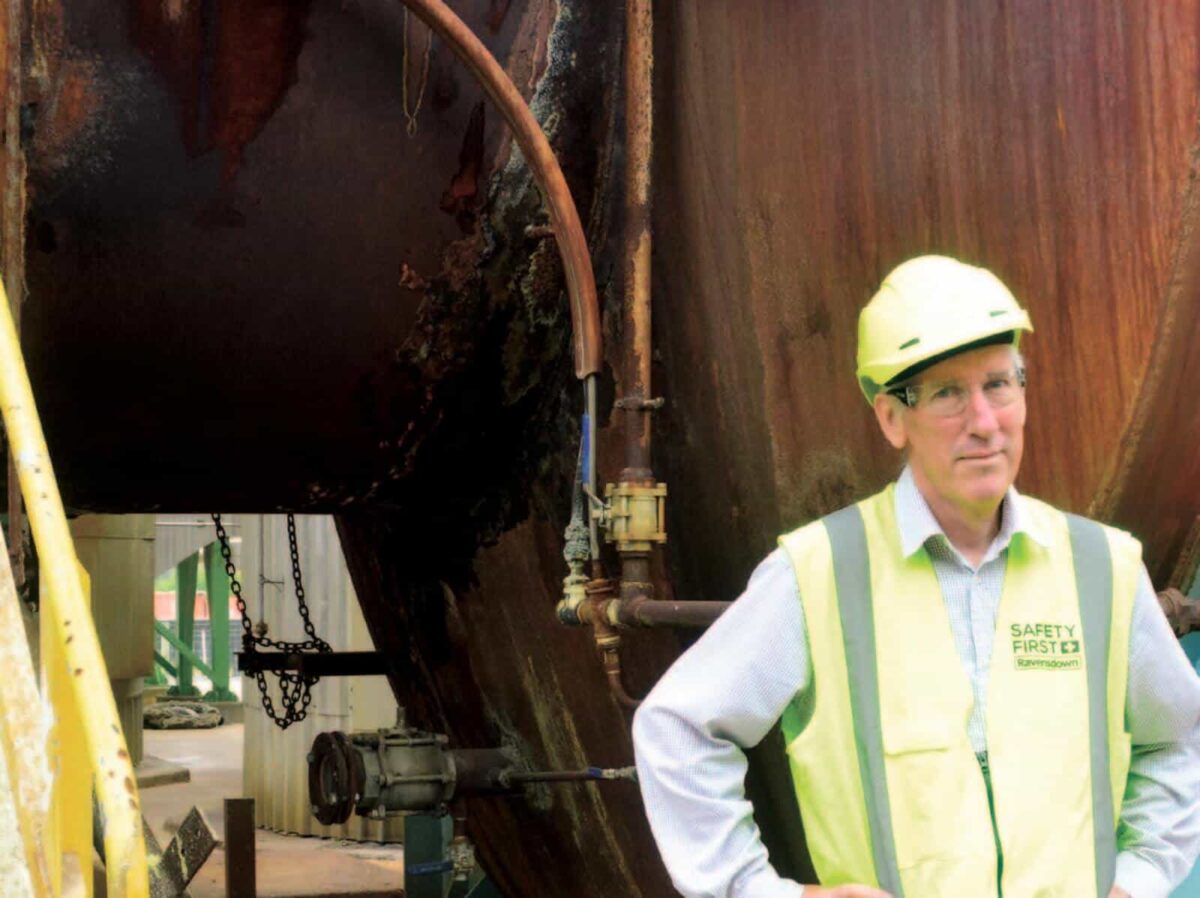It is annual survey of business priorities, the Energy Efficiency and Conservation Authority (EECA) says energy conservation and reducing carbon emissions never makes it into the top three or four areas of importance.
Greg Visser, EECA general manager, says businesses and agencies seem to be too busy simply keeping the wheels turning with additional responsibilities, including health and safety compliance, pushing energy considerations further down the list.
Without an external price on climate change and carbon emissions, says Visser, there’s a problem. “If it was really expensive not to comply it might make businesses sit up and take notice.”
While Hawke’s Bay local authorities have been slow to engage, some larger organisations, including Hawke’s Bay District Health Board (DHB), Ravensdown and Napier Port, are taking the challenge seriously, recognising that even small savings have a long-term impact on their bottom line.
EECA offers energy efficiency audits for businesses, councils and other public entities, targeting 10-20% savings, typically starting with its web-based Energy Management Journey (EMJ).
‘Customers’ initiate the process by ticking boxes and fi lling out forms which benchmark them against 450 other businesses in their sector.
They end up with a set of recommendations about where to focus, depending on whether they’re just starting out, committed but uncertain, have a plan but need help, or are mature but not sure of the next steps.
Low hanging fruit
The ‘best practice’ tool is based on over 2,500 audits of New Zealand companies, where experts have determined where the ‘low hanging fruit are’ and integrated those fi ndings into the EMJ tool.
Visser says many countries have made a start but EECA is leading the way in bringing it all together, providing recommendations and suggesting which partner to call.
There’s been a mixed response to its e orts to bring energy conservation “up the pile” of priorities, and it has to keep reinforcing the fact that it’s free. It prefers some resources be committed by customers, but says many are “constrained on capability and capacity and can’t focus”.
The latest EECA Strategy for 2017- 2022 confi rms behavioural barriers are an obstacle to engagement: “It takes a deliberate e ort to change the way an organisation thinks about energy use, e.g. providing good information, teaching new practices, and learning to think from a di erent perspective.”
The pitch is, that when plant or buildings operate more efficiently, this reduces both the energy bill and carbon emissions. Timing is all important; if EECA’s programme doesn’t get into the annual budget process “you get one cycle behind again”.
Visser says businesses typically respond to market signals, “but if there’s no price signal then it’s pretty difficult.”
Long-term thinking
While escalating production or adding another machine may deliver commercial e
ciencies, hospitals and councils have a di erent funding model with longer term imperatives.
HB District Health Board’s team of engineers and project managers integrate energy effciency into the design of all projects and make daily improvements.

“It may be as simple as investing an extra 6% in the correct building cladding to give us 10-20 years more life, reduced cost and maintenance,” says facilities manager Gavin Carey-Smith.
After creating the space and time to evaluate efficiency measures at its Omahu Rd hospital, the DHB has become “passionate about reducing its carbon footprint, energy use and lifecycle costs”.
Carey-Smith’s team undertook a major energy performance contract with Honeywell for a new building management system to control, monitor and report on the performance of air conditioning, motors, drives, refrigeration systems, chilled and hot water and lighting.
The contract began after guidance and some funding from EECA, and like its other partners, Honeywell guaranteed return on investment within a given timeframe or they’d pick up the difference.
“We made signifi cant savings – a 5% improvement annually in kilowatt hours, about $70,000 annually,” says Carey-Smith.
A team e ort was required with staff engaged in training and one person committing 50% of their time to the project.
“It may be as simple as investing an extra 6% in the correct building cladding to give us 10-20 years more life, reduced cost and maintenance.” GAVIN CAREY-SMITH, HB DISTRICT HEALTH BOARD FACILITIES MANAGER
Payback was promised within 6.5 years and while Honeywell didn’t quite make its target and had to refund the di erence, the ongoing partnership benefi ts both parties.
Carey-Smith recommends the ‘performance contract’ approach but says the contract needs to be set up carefully; “if you do it right the contract company has to deliver the changes promised”.

Energy savings are captured by current upgrades to older buildings, including work on the mental health and endoscopy areas, having full insulation in the ceiling spaces, double glazed windows and LED lighting. “It’s part of our culture now.”
Councils lag
Meanwhile Hawke’s Bay councils appear to have been late to the game, with EECA’s regional account managers only recently invited by Hastings and Napier cities to audit their energy use.
It has been in discussion with both councils “around some of their operations” and how it might help. “We’re still working this through … when they’re ready to engage we can help them on their journey.”
Visser says councils can start to show leadership by looking at building lighting, heating and cooling, “pulling businesses and communities along with them, and showing they’re using ratepayer dollars more effectively”.
“If it starts with a consultation draft put together by technocrats then the direction is already set… by whoever has the loudest voice in the room, often finance or engineers.” CHRIS PERLEY, STRATEGY CONSULTANT
No takers for loans
One way to progress conservation projects is through EECA’s interest-free $2 million quarterly Crown loans; the latest round closed in February. No applications have been received from local councils, schools or public institutions in over a year.
Around 40 loan projects achieved cumulative savings of $9 million and carbon reductions of over 5,000 tonnes each over the past five years.
Visser says the opportunity should be taken more seriously by Hawke’s Bay, which is still at the start of the journey. “Some other regions are far more mature in their energy conservation e orts, so we’re looking to get traction.”
A successful scene-setter has been the Hastings and Napier council-owned Omarunui Landfi ll project with Pioneer Generation, commended at the EECA award in May 2016 “as an outstanding example of renewable energy with multiple benefi ts”.
The $1.8m project transforms biogas (methane) from the 70,000 tonnes of waste compacted annually, generating enough electricity to power 1,000 homes.
EECA joined Hawke’s Bay Regional Council (HBRC) and several local businesses looking at regional energy needs over a year ago, as part of the Regional Economic Development Strategy (REDS).
While HBRC wants to provide leadership, “businesses do what’s good for them,” says Visser but it’s not just what benefi ts their “back pocket” but what’s good for the public, as “tax payers need to see benefi ts too”.
HBRC’s energy stakeholders group is preparing a long-term strategy for energy use, e
ciency and reducing the region’s carbon footprint, with promotion of electric vehicle use high on the agenda.
Hawke’s Bay consultant Chris Perley remains concerned at the way regional challenges such as energy are approached, believing strategies need to be resilient, less centralised and fl exible enough to accommodate new technology and adapt to unforeseen changes.
He says bureaucrats often work out all the options beforehand, leaving those who are consulting to tick the boxes, with little room for fresh thinking.
“If it starts with a consultation draft put together by technocrats then the direction is already set…by whoever has the loudest voice in the room, often fi nance or engineers.”
If its left to engineers, he says, they’ll often stick with the most efficient way to solve a problem, which results in situations like heavy traffic using Marine Parade as the quickest way to Napier Port while ignoring the multifunctional use of that road.
In economic development, says Perley, who’s a vocal advocate for rethinking our energy use, the best results may come from thinking more creatively and putting culture ahead of structure. Otherwise, he warns you end up “building a supertanker that’s hard to turn around”.
Where you start is all important, and before anything is written down the process should start at the grassroots, “canvassing and talking openly with people, like Hastings mayor Lawrence Yule did with the GMO and fracking issues.”
Perley says the first thing is to fi gure out how to use less, whether it’s a milking shed, factory or house. “Reduce your energy needs then start looking at passive systems and building design, and the cool things that are happening with sustainable technology including micro-hydro.”
And while some have dismissed solar, wind and even electric cars as not being economically viable, he says the ‘threshold e ect’ needs to be kept in mind; in other words, what happens when the technology matures, becomes a ordable and reaches critical mass?
The EECA Strategy, which sets the overarching policy direction for government support and intervention, states New Zealand’s emissions are mainly from agriculture and energy (including transport), with the energy sector making up nearly 40% of gross emissions.
It asserts that, as climate change issues become more important, export markets are likely to start focusing on “embodied carbon in imported goods and perhaps even services”.
EECA’s Visser believes great opportunities for savings exist in the meat and dairy sectors, including horticulture and wineries. He cites wood processing as another area of “signifi cant opportunities”. The goal for these sectors is to wean them o fossil fuels to gas as a “transitional fuel” then “renewable energy where it makes sense”.
Industrial use
Based on “current technology and without reducing existing economic activity”, the EECA Strategy suggests process heat and transport sectors provide the greatest potential reduce emissions.
An average “decrease in industrial emissions intensity of one per cent per annum between 2017 and 2022” is suggested.
However, Environmental Defence Society (EDS) director Professor Barry Barton, claims that target is simply “business as usual” – if the government was serious it should aim higher.
He wants economy-wide and sector- specifi c targets and details about how targets would be met. “We need to get to zero net emissions of greenhouse gases by mid- century and that will require fundamental shifts in energy use.”
While the target is 2% of the vehicle fl eet being electric by 2021, EDS is concerned there’s nothing in the strategy to improve internal combustion vehicles that’ll be on our roads for years to come.
Barton calls for urgent action on promised mandatory fuel efficiency standards, similar to those imposed in other developed countries.
The EECA Strategy says process heat makes up a third of our energy use, contributing 9% of gross emissions; 60% of that from fossil fuels, mainly coal and gas, with the industrial sector contributing 80% of that.
It says the switch to renewable energy o ers a cost-effective opportunity to improve energy efficiency by 4% to 12% between 2010 and 2030.
Process heat is used to heat schools, universities, offices and other buildings; creating steam for sterilisation in hospitals; and in the industrial and commercial sector to heat water, and with hot gases, power boilers for processing raw products including milk powder.
The Ravensdown fertiliser plant at Awatoto prides itself on reusing the heat and gas it generates to power a lot of its needs.
The heat from its sulphuric acid manufacturing process runs a 6.5 megawatt generator which at full production can meet all its energy needs and put enough spark back into the national grid to power an eighth of the houses in Napier.
Kieran Murray, Ravensdown’s Napier works manager says the acid plant (used to process the fertiliser for use on farms) uses gas to steam, gas to gas and gas to water heat exchangers for cooling and heating.
“The gas to water heat exchanger reduces the need for other forms of energy to pre- heat water for the boiler and the gas-gas heat exchangers cool and heat up the opposite sides of the gas fl ow meaning the whole process is self-recovering.”
While it takes 100,000 litres of gas to warm the plant up, once it gets going it burns sulphur which is “exothermic” or self-driving, virtually providing free heat. The plant can produce up to 32 tonnes of superheated steam every hour, says Murray.
The site can also retain 600 tonnes of storm water for its processes.

Murray says Ravensdown’s process engineering team continually look to improve energy performance and is currently considering LED lighting to further reduce the energy footprint.
“While it takes 100,000 litres of gas to warm the plant up, once it gets going it burns sulphur which is “exothermic” or self-driving, virtually providing free heat.” KIERAN MURRAY, RAVENSDOWN’S NAPIER WORKS MANAGER
What about transport?
EECA’s Visser says the strong focus on reducing transport emissions needs to be realistic. It’s working closely with companies to understand the drivers and constraints, but admits the best outcome doesn’t always align with “the theoretical ideal”.
While KiwiRail’s controversial decision to return to diesel is “not an ideal outcome”, he says, people miss the fact it’s “a diesel hybrid that runs on an electric motor”.
That’s “really efficient compared to having trucks on the road” and allows KiwiRail to make better use of spur lines. “If we’re too evangelical about what we promote we end up getting nowhere.”
Ports are big energy users, including ships that use diesel generators while docked. “We need to look at more renewable and green solutions,” says Visser, including other power sources for refrigerated containers.
“Some real innovations are happening and we’re working with ports to see if they stack up and hopefully have these rolled out across the country.”
Napier Port has a number of high level aspirations and ongoing projects to further reduce its carbon footprint and save energy and is looking at a range of new technologies and approaches to progress this.
It’s about to appoint an environmental advisor to pull its various energy projects into an overarching plan.
The Port’s 2016 annual report says electricity consumption dropped by 2.5% during 2016, greenhouse gas emissions reduced by 0.8% and since 2010 it has cut the amount of waste it sends to landfill by76% or 478 tonnes.
Strategy consultant Chris Perley believes getting buy in from Hawke’s Bay businesses and individuals for energy conservation requires a more integrated and strategic way of engaging and making policy; in other words, a culture change.
He says there’s plenty of knowledge around but it’s not being captured. Those with the best ideas, whether a junior or a Maori kuia, are often not listened to or constrained by old school thinkers who hold fast to “this is what we do … this is how we do it”.
Perley says incentives for changing practice have to be cultural and fi nancial with a clear value behind them, whether that’s using public transport or planting trees. “It requires working deeply with communities and it takes time – people aren’t loners.”
Unison is pleased to sponsor robust examination of energy issues in Hawke’s Bay. This reporting is prepared by BayBuzz. Any editorial views expressed are those of the BayBuzz team.

